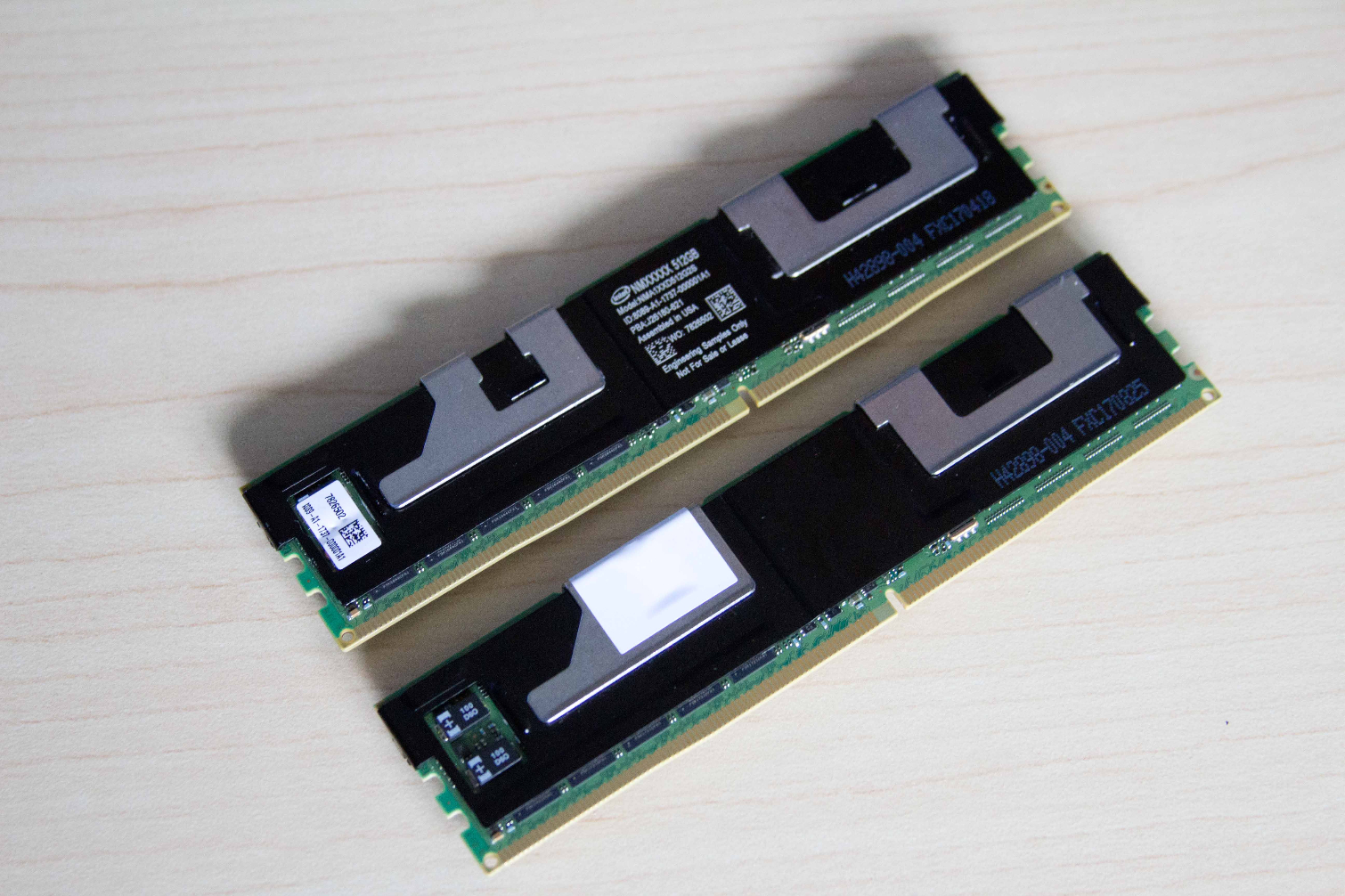Intel Displays 512GB Optane DC Persistent Memory DIMMs
Intel held its Memory and Storage day today at its Santa Clara headquarters to announce its Optane DC Persistent Memory DIMMs. The new DIMMs slot into the DRAM interface, just like a normal stick of RAM, but come in three capacities of 128, 256, and 512GB. That's a massive capacity increase compared to the industry-leading 128GB DDR4 memory sticks. Intel designed the DIMMs to bridge both the performance and pricing gap between storage and memory, so the new DIMMs should land at much lower price points than typical DRAM.
The new modules use Intel's 3D XPoint memory and can be addressed as either memory or storage. Unlike DRAM, 3D XPoint retains data after power is removed, thus enabling radical new use cases. 3D XPoint is also fast enough to serve as a slower tier of DRAM, but it does require tuning the application and driver stacks to accommodate its unique characteristics.
Unfortunately, the leading DIMM products are designed for data centers, so they won't come to desktop PCs in the near future. For now, the DIMMs enable up to 3TB of memory capacity per server CPU socket. Current-gen Purley processors do not support the new DIMMs, but Intel is adding support with its forthcoming Cascade Lake Xeons. Intel hasn't announced a firm release date for the new Xeon lineup, but it appears they will arrive in tandem with the new persistent DIMMs. Intel also would not confirm if all Cascade Lake Xeon SKUs will support the Optane DIMMs, or if it would limit support to pricier models.
Intel had 256 and 512GB modules on display at the event. We spotted a few capacitors near the edge of the device. These capacitors provide enough power to flush data to the storage during a power loss, but they are typically used to flush data from the embedded DRAM on SSDs. Intel may be using complimentary DRAM on the modules, but the company isn't sharing details.
We counted 11 chips underneath the heat spreader. Company representatives confirmed the modules also contain "support chips," but they wouldn't elaborate further. The original versions of the modules, which we spotted at Storage Visions 2016, included an FPGA to manage the device.
Much like NAND, 3D XPoint has a finite lifespan. Intel isn't sharing specific endurance specifications, but did say that the modules would be sufficient for the "expected lifecycle." Intel wouldn't confirm the length of the expected lifecycle, or if heavier workloads would adversely impact the endurance rating.
Intel is using first-gen 3D XPoint for the modules, and much like SSDs, the DIMMs likely include overprovisioning to improve endurance. Based upon the standard 3D XPoint package density, it appears the 512GB modules have 640GB of total capacity. That leaves an extra 128GB of capacity dedicated to overprovisioning and ECC mechanisms.
Get Tom's Hardware's best news and in-depth reviews, straight to your inbox.
Intel isn't sharing more granular specifics, but we learned several details earlier this year from Lenovo. The company told us that the thicker DIMM design would require specialized motherboards and that the modules generate enough heat to warrant specialized cooling solutions. The company also told us that the DIMMs consume about 3X the power of a standard 8/16GB DDR4 DIMM. The actual value could range from 15-18W depending on the workload. Power consumption is a huge consideration in the data center, and gaining 32x the memory capacity in exchange for a 3x increase in power consumption is a dramatic improvement.






The new class of memory will require new programming models to unleash the full performance benefit. 3D XPoint DIMMs will piggyback on the same software and programming models that enable the NVDIMM ecosystem, which should help speed adoption. Intel also supports the new open-source Persistent Memory Development Kit (PDMK), which cuts through the standard driver and filesystem layers to allow faster access to the memory.
To facilitate application development, Intel is opening up the new DIMMs to developers via its remote-access Builders Construction Zone. Meanwhile, the company is sampling modules to its partners today and expects to ship in volume early next year.

Paul Alcorn is the Editor-in-Chief for Tom's Hardware US. He also writes news and reviews on CPUs, storage, and enterprise hardware.
-
nitrium "Based upon the standard 3D XPoint package density, it appears the 512GB modules have 640GB of total capacity."Reply
"640K ought to be enough for anybody." - Bill Gates. Well apparently it isn't actually true, but the "640GB" did bring a smile to my face. -
grimfox Reply21014472 said:watch has Corsair comes out with 512gb RGB "Gaming" Sticks
/s
Intel has a patent on X-point so unless Intel releases a "skull" version I wouldn't expect these to come in RGB, and doubtful they'll come from Corsair anytime soon. Intel isn't big on licensing their tech.
Yes, I saw the /s I'm just being an arse on the internet. -
jimmysmitty Reply21015578 said:21014472 said:watch has Corsair comes out with 512gb RGB "Gaming" Sticks
/s
Intel has a patent on X-point so unless Intel releases a "skull" version I wouldn't expect these to come in RGB, and doubtful they'll come from Corsair anytime soon. Intel isn't big on licensing their tech.
Yes, I saw the /s I'm just being an arse on the internet.
Considering how many technologies in computers these days had Intel highly involved I wouldn't doubt that this will eventually become a more open standard for consumers and have DIMMs provided by other companies like Corsair, Kingston etc.
Still this is the first step to having a more all in one system that has something vastly faster than even M.2 or PCIe SSDs can provide. Most mainstream CPUs currently push 35GB/s in bandwidth with top end being in HEDT with 60-65GB/s. Plus have 4 512GB modules and assign 128GB to memory and the rest to storage. Or imagine if they push into the TB per stick or more. It is exciting as storage has always been a massive bottleneck. Of course this will then push software to being the major bottleneck that will need to be written to take advantage of it but man imagine how fast things will load. -
Lucky_SLS Serve memory is limited to quad channel. But these dimms can be set in raid 0 with 8 of them working together for dram class memory transfer speeds i guess...Reply -
Gh0stWalker These NVDIMMS (?) would be great to become the next OS boot drive. Especially for older quad channel motherboards with some spare DIMM slots, but no provision for say 2280 etc nvSSD. But I don't fancy my chances with this even though Intel could sell millions of them - they will want the whole box and dice upgrade, processor/motherboard/ram etc... Maybe if the trade war with China heats up we can go to Alibaba and get some cheap and cheerful knockoffs! The market abhors a vacuum after all, and a controlled market is not efficient... Maybe the FTA between TPP states (sans 'murica) will negate the exchange rate and sales tax extortions too. Geeez I love true competition in a true free market :)Reply -
papality "Intel isn't sharing specific endurance specifications, but did say that the modules would be sufficient for the "expected lifecycle." Intel wouldn't confirm the length of the expected lifecycle, or if heavier workloads would adversely impact the endurance rating. "Reply
So we can pretty safely assume it's low enough that it would be alarming if they announced it publicly.


